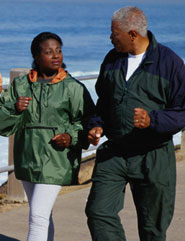|
Our Services Follow Us
Benefits of In Home Personal Training
-Personal Trainers in Maryland
-Personal Trainers in Pennsylvania
-Personal Trainers in Virginia
Every Body's Personal Trainer Accessories
Free Resources Personal Trainer/Owner Eric Leader's Blog
Company Information Every Body's Personal Trainer in the Media/Press
Physique Transformation Competition
Every Body's Personal Trainer Client Feedback
Call Now!!! (443) 615-2702 Or
Follow Us
|
How much exercise do you need?
The good news about regular physical activity is that everyone can benefit from it. Additionally, physical activity does not need to be hard or challenging. Participating in moderate-intensity physical activity is an important part of a healthy lifestyle for people of all ages and wide range of abilities.1
Current physical activity recommendations for adults include both cardio or aerobic activities and resistance, strength-building, and weight-bearing activities.
| Recommendations for Adults | ||||||||
|---|---|---|---|---|---|---|---|---|
|
What types of aerobic activities are considered moderate-intensity?
During moderate-intensity activities you should notice an increase in your heart rate, but you should still be able to talk comfortably. If you are breathing hard and fast and your heart rate is increased substantially, you are probably doing vigorous-intensity activity. Many activities (such as bicycling or swimming) can be either moderate- or vigorous-intensity depending on your level of effort. See the measuring intensity section for more information. More examples of moderate-intensity activity are provided below.
| Indoors | Outdoors | Indoors or Outdoors |
|---|---|---|
| • Dancing, general (Greek, Hula,
Flamenco, Middle Eastern and Swing) • Riding a stationary bike • Actively playing with children • Taking Jazzercise • Scrubbing the floor |
• Mowing lawn, general • Frisbee playing, general • Playing golf, walking the course • Shoveling light snow • Downhill skiing with light effort • Raking leaves |
• Playing basketball, shooting
hoops • Walking, brisk pace (mall/around a track/treadmill) • Doing water aerobics • Jogging/walking combination (In a 30-minute period, you should be jogging for less than 10 minutes.) |
For more examples of activities that are considered "moderate-intensity" and
"vigorous-intensity," check out
General Physical Activities Defined By Level of Intensity![]() (PDF-64k.)
(PDF-64k.)
 What
are ways to get the amount of physical activity that I need?
What
are ways to get the amount of physical activity that I need?
You can reach your goal of at least 30 minutes of moderate-intensity physical activity most days of the week in more than one way: you can do one type of activity for at least 30 minutes, or you can break down your minimum of 30 minutes of physical activity into smaller, 10- to 15-minute segments.3
Think of it as the 3-2-1 plan!
3 – Complete three activities for 10 consecutive minutes at a moderately intense rate
OR
2 – Complete two activities for 15 consecutive minutes at a moderately intense rate
OR
1 – Complete one activity for 30 consecutive minutes at a moderately intense rate
Follow the 3-2-1 and stick with it!
What types of aerobic activities are considered vigorous-intensity?
Most people can get greater health benefits by increasing the intensity or the amount of time that they are physically active. Incorporating up to 60 minutes of moderate- to vigorous-intensity physical activity may also help you manage your weight or help you prevent weight gain, whatever your goal may be.
| Racewalking, jogging or running | |
| Swimming laps | |
| Mowing lawn, hand mower | |
| Tennis, singles | |
| Bicycling more than 10 mph, or on steep uphill terrain | |
| Moving or pushing furniture | |
| Circuit training – a combination of strength, endurance and aerobic exercises |
Experts advise that people with chronic diseases, such as a heart condition, arthritis, diabetes, or high blood pressure, should talk to their doctor about what types and amounts of physical activity are appropriate. For more, see When is a medical evaluation necessary?
| Are there special recommendations for young people? | |
| Are there special recommendations for older adults? |
References
11996 Surgeon General's Report on Physical Activity and Health, page 37
![]() Please
note: Some of these publications are available for download only as *.pdf files.
These files require Adobe Acrobat Reader in order to be viewed. Please review
the information on downloading
and using Acrobat Reader software.
Please
note: Some of these publications are available for download only as *.pdf files.
These files require Adobe Acrobat Reader in order to be viewed. Please review
the information on downloading
and using Acrobat Reader software.
* Links to non-Federal organizations found at this site are provided solely as a service to our users. These links do not constitute an endorsement of these organizations or their programs by CDC or the Federal Government, and none should be inferred. CDC is not responsible for the content of the individual organization Web pages found at these links.
Page last updated: March 26, 2008
Content Source: Division of Nutrition, Physical Activity and Obesity, National Center for Chronic Disease Prevention and Health Promotion